About Authors:
Mary Joseph Parakka2*, Dr. Smita Nayak 1,
1Professor, HOD Department of Pharmaceutics
2Bachelors of Pharmacy, Gahlot Institute of Pharmacy, Navi Mumbai.
*mparakka@gmail.com
Abstract:
This review article is mainly focused on the recent and efficient methods of drug delivery in Transdermal drug delivery system; namely Sonophoresis and Nanotechnology ( as Nanoparticles).
Application of these methods in transdermal drug delivery has improved patient compliance and opened new techniques in T.D.D.S
REFERENCE ID: PHARMATUTOR-ART-1752
INTRODUCTION:
Human skin serves a protective function by imposing physicochemical limitations to the type of permeant that can traverse the barrier. For a drug to be delivered passively via the skin it needs to have a suitable lipophilicity and a molecular weight <500 Da. Unfortunately, a significant obstacle to dermal and transdermal drug delivery alike is the resilient barrier that the epidermal layers of the skin, primarily the stratum corneum, presents for the diffusion of exogenous chemical agents.
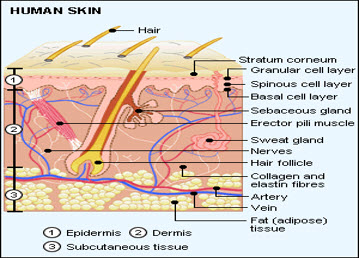
STRUCTURE OF THE HUMAN SKIN
The number of commercial available products based on transdermal or dermal delivery has been limited by these requirements. In recent years various passive and active strategies have emerged to optimize Delivery. The passive approach entails the optimization of formulation or drug carrying vehicle to increase skin permeability. However passive methods do not greatly improve the permeation of drugs with molecular weights >500 Da. In contrast active methods, normally involving physical or mechanical methods of enhancing delivery have been shown to be generally superior.
A transdermal delivery system mainly is composed of drug reservoir, drug release (release rate controlling) membrane, a polymer system, an adhesive. The membrane system is usually perforated for better drug transport through the skin surface.
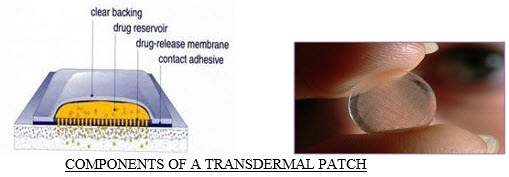
Example: Scopolamine transdermal patch, nicotine patch
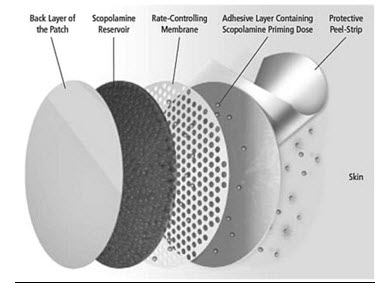
SCOPALAMINE TRANSDERMAL PATCH
MECHANISM OF DRUG DELIVERY THROUGH SKIN
The drug release process mainly consists of four stages: the drug releases from the formulation, diffuses across the stratum corneum (SC) via tortuous intercellular lipid path-way, transfers from SC into epidermis, and then enters the systemic circulation via capillary network.
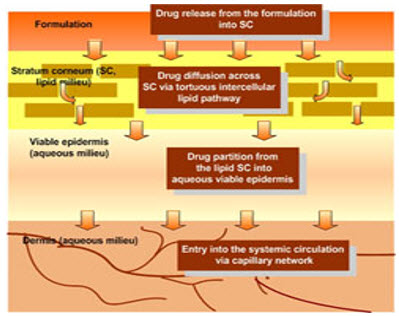
Various Approaches involved in Transdermal drug delivery to enhance permeation of drugs:
PHYSICAL APPROACHES -
· Iontophoresis
· Phonophoresis ( also known as sonophoresis-uses ultrasound apparatus generating frequencies in the range 0.7-1.1 MHz)
CHEMICAL APPROACHES–
Permeation enhancers: These include the following:
a) Solvents
b) Surfactants
* Anionic surfactants
* Cationic surfactants
* Bile salts
c) Binary systems
d) Miscellaneous chemicals
Newer and Recent techniques used in Transdermal drug delivery
Sonophoresis:
Application of ultrasound to the skin increases its permeability (sonophoresis) and enables the delivery of various substances into and through the skin. Ultrasound has been used extensively for medical diagnostics and to a certain extent in medical therapy.The generation of ultrasound and mechanism of sonophoresis with particular emphasis on the role of cavitation (both inside and outside the skin), thermal effects, convective transport, and mechanical effects also included. Sonophoresis is a localized, non?invasive, convenient and rapid method of delivering low molecular weight drugs as well as macromolecules into the skin.
The ultrasound waves generate tiny bubbles of water on skin surface; this causes the skin surface to lightly get worn out. This allows the drug to pass through the skin surface efficiently. Sonophoresis occurs because ultrasound waves stimulate micro-vibrations within the skin epidermis and increase the overall kinetic energy of molecules making up topical agents.Sonophoresis, or ultrasound, creates holes in the skin, and allows fluids to travel into or out of the body. When sound is emitted at a particular frequency, the sound waves disrupt the lipid bilayers. This method can be used for delivery of steroids, systemic drugs such as Insulin and antigens for vaccination. Ultrasound transdermal drug delivery system in noninvasive way is used for Diabetics to control blood sugar level through short term and long term delivery of Insulin. Noninvasive drug delivery (as capsule formulation) is used for acne, psoriasis. These systems enhance activity of transdermal patches.The higher the frequency, the more dispersed the transmission.
Advantages of using sonophoresis as a physical penetration enhancer
• Enhanced drug penetration (selected drugs) over passive transport.
• Allows strict control of transdermal penetration rates.
• Low risk of introducing infection as the skin remains intact
• Reduction of dosing frequency and patient compliance.
• Improved control of the concentrations of drugs with small therapeutic indices.
• Reduction of fluctuations in plasma levels of drugs.
• Avoids hepatic first pass elimination and gastrointestinal irritation.
• Substitutes oral administration when the route is unsuitable as in case of vomiting, diarrhea.
• Permit both local and systemic effects and less risk of systemic absorption than injection.
• Easy termination of drug delivery in case of toxicity, through termination of ultrasound.
Disadvantages of using sonophoresis as a physical penetration enhancer
• Stratum corneum must be intact for effective drug penetration.
• Can be time consuming to administer.
GENERATION OF ULTRASOUND:
Ultrasound is generated using a device referred to as a sonicator. It consists of an electrical signal generated which generates an electrical AC signal at the desired frequency and amplitude. This signal is applied across a piezo-electrical crystal (transducer) to generate ultrasound the thickness of the operating frequency. Sonicators operating at various frequencies in the range of 20 kHz to 3 MHz are available commercially and can be used for sonophores.Ultrasound is applied by contacting the transducer with the skin through a coupling medium to ensure a proper contact between the transducer and the skin.
COMMERCIALLY AVAILABLE SONOPHORETIC SYSTEMS
- Patch Cap and U strip
- Sonoderm Technology
- SonoPrep
- Microlysis
APPLICATIONS OF SONOPHORESIS
There are certain applications of sonophoresis technique in the transdermal drug delivery system are given as follows:
* Ultrasound helps in treatment of wide varieties of sports injuries such as tennis elbow, tendon problems, repairing damaged ligaments, muscle spasms, stiff joints, fractured bones and cartilage. Also used in healing of wounds, damaged skin, skin rejuvenation, nerve stimulation, and improving the strength and elasticity of scar tissues.
* Ultrasound with Topical Anesthesia rapidly decreases pain of intravenous cannulation.
* Low?frequency ultrasonic gene delivery.
* The dolphin therapy arouses a great interest in the whole world, since it causes analgesic effects, removal of depression, and improvement of learning abilities of the children suffering from autism.
* Sonophoresis is also being used in drug enhancement in granulomas and tumors.
* Sonophoresis is being investigated as a way of extracting compounds such as glucose.
* In the treatment of sick fish by University of Maryland‘s Center of Marine Biotechnology. The current method uses intraperitoneal injections which are costly and highly labour intensive. In this experiment, ultrasound was applied to water containing fish and compound of interest. The ultrasound waves increases the permeability of compound into the tissues of the skin and gills. This method is highly cost and labour effective.
* Sonophoresis also used in treatment of glaucoma, corneal infection and nail delivery, to Increase the permeability of drugs.
Nanotechnology
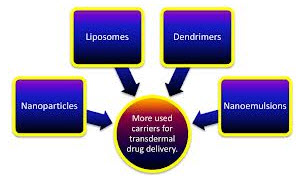
Nanoparticles are used as drug carriers to slowly degrade at the specific site. These particles are used for targeting drug into the skin, the targeting are mainly Active or Passive.
Passive targeting- e.g.: Accumulation of chemotherapeutic agents on tumor cells.
Active targeting- e.g.: Chemical decorating of drug surface carrier with molecules to selectively attach to diseased cells. Controlled release of drug is also possible in the form of sustained release form and pulsatile dosage form.
Sustained Release-continuous release of drug at controlled rate by diffusion out of polymer or degradation of polymer.
Pulsatile Release: It is usually preferred as it mimics the way body naturally produces hormones
E.g. insulin.
Nanoparticles are smaller than 1,000 nm. Nowadays, it is possible to insert many types of materials such as drugs, proteins, peptides, DNA, etc. into the Nanoparticles. They are constructed from materials designed to resist pH, temperature, enzymatic attack, or other problems Nanoparticles can be classified as nanospheres or nanocapsules Nanospheres are solid-core structures and nanocapsules are hollow-core structures.
Nanospheres are solid-core structures and nanocapsules are hollow-core structures.
Nanoparticles can be composed of polymers, lipids, polysaccharides and proteins. Nanoparticles preparation techniques are based on their physicochemical properties. They are made by emulsification-diffusion by solvent displacement, emulsification polymerization, in situ-polymerization, gelation, nanoprecipitation, solvent evaporation/ extraction, inverse salting out, dispersion polymerization and other derived from these one.
More used transdermal nanocarriers
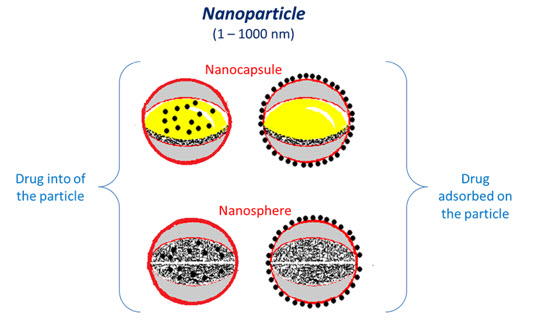
Nanoemulsions
Nanoemulsions are isotropic dispersed systems of two non miscible liquids, normally consisting of an oily system dispersed in an aqueous system (o/w Nanoemulsions), or an aqueous system dispersed in an oily system but forming droplets or other oily phases of nanometric sizes (100 nm). They can be stable (methastable) for long times due to the extremely small sizes and the use of adequate surfactants. Nanoemulsions can use hydrophobic and hydrophilic drugs because it is possible to make both w/o or o/w nanoemulsions .They are non-toxic and non-irritant systems and they can be used for skin or mucous membranes, parenteral and non parenteral administration in general and they have been used in the cosmetic field. Nanoemulsions can be prepared by three methods mainly: high-pressure homogenization, microfluidization and phase inversion temperature. Transdermal delivery using nanoemulsions has been reduced due to the stability problems inherent to this dosage form.
Liposomes:
Liposomes are nano size artificial vesicles of spherical shape that can be
produced from natural phospholipids and cholesterol.
• Liposomes are broadly classified by their structure.
Multilamellar liposomes: Spherically concentric multilamellar (many
bilayers) structure
• Unilamellar liposomes: Spherical concentric unilamellar (one bilayer)
structures
The properties of liposomes in addition to the general properties of
surfactants those make them useful for different applications are
• Structural stability on dilution
• Varying permeability of the bilayer to different molecules.
• Ability to entrap both water soluble and insoluble substances and deliver them into desired environments.
The size, lamellarity (unilamellar or multilamellar) and lipid composition of the bilayers influence many of the important properties like the fluidity, permeability, stability and structure -these can be controlled and customized to serve specific needs. The properties are also influenced by external parameters like the temperature, ionic strength and the presence of certain molecules nearby.
Liposomes is extensively studied for encapsulation of drugs. When lipid self assemble to liposomes water-soluble drugs will be trapped inside the liposomal cavity; fat-soluble drugs are incorporated within phospholipid bi- layer. The lipid bilayer of the liposome can fuse with other bilayers (e.g. cell membrane), thus delivering the liposome contents.
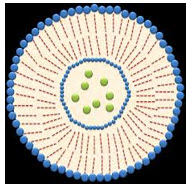
APPLICATIONS OF NANOPARTICLES
· Recent advances in the study of penetration mechanisms deal with the control of the intercellular penetration route by the crystalline state of lipids, and the penetration through skin appendages (the follicular pathway) that appears to contribute much more than was previously thought.
· Applications dependent on skin penetration that have received special attention include transdermal delivery of nano- and microparticles by hair follicles, especially for nanoparticles which penetrate hair follicles very efficiently targeting the skin immune system in order to develop new vaccination strategies, and problems relating to skin diseases.
CONCLUSION:
Ultrasound drug therapy in T.D.D.S is an efficient method of drug transport through the skin surface .It also is a noninvasive method with patient compliance. The numerous attempts made over the last 50 years can be classified into three categories; therapeutic frequency, high frequency and low frequency ultrasound; the first represents the most commonly used ultrasound condition for sonophoresis although recently attention has been more focused on low and high frequency condition.
Nanocarriers have shown many advantages for topical and transdermal delivery of drugs. It could be shown already for various drugs that topical/transdermal formulations containing Nanoparticles can enhance the penetration into the skin increasing treatment efficiency, target the epidermis or follicles, reducing side effects. Furthermore, an increased activities as Well as prolonged activities have been reported. These delivery systems can deliver both hydrophilic and lipophilic molecules. Advances with regard to materials, fabrication methods and techniques facilitate the development of new and better nanocarriers. Nonetheless, future researches must ensure the benefit and evaluate the risk ratio for many drugs included in nanocarriers.
REFERENCES:
1. Sinha VR, Kaur MP. Permeation enhancers for transdermal drug delivery. Drug Dev Ind Pharm 2000; 26:1131? 1140.
2. Ansel's Pharmaceutical Dosage Forms and Drug Delivery System. 300-303
3. Fellinger K, Schmidt J. Klinik and Therapies des Chromischen Gelenkreumatismus, Maudrich Vienna, Austria 1954: 549–552.
4. fda.gov/downloads/Drugs/…/Guidance’s/UCM220796.pdf
5. onlinelibrary.wiley.com/doi/10.1111/cbdd.12008/pdf
6. Handbook of non invasive drug delivery systems: science and technology
7. Mitragotri, S.Kost.J, 2004, low frequency sonophoresis:a review , Adv. Drug delivery Rev, 589-601.
NOW YOU CAN ALSO PUBLISH YOUR ARTICLE ONLINE.
SUBMIT YOUR ARTICLE/PROJECT AT articles@pharmatutor.org
Subscribe to Pharmatutor Alerts by Email
FIND OUT MORE ARTICLES AT OUR DATABASE


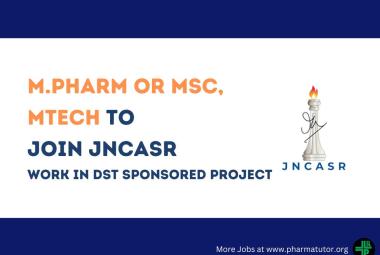
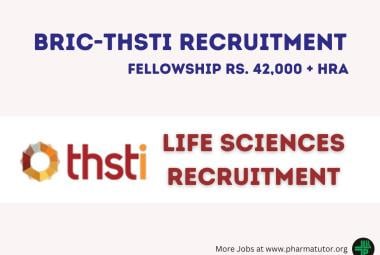


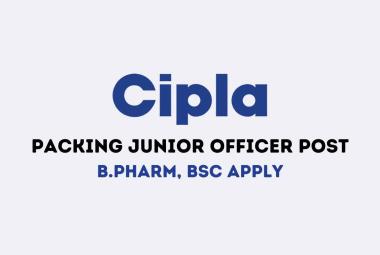



.png)


